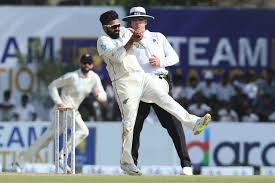Reading Time: 7 minutes
Vijayhardik profiles two individual performances shaped the outcomes of the matches. Steve Smith his fighting 92 brought Australia and close to England’s first innings and total and bought them some time. On the other hand, the newly minted Sri Lankan skipper Dimuth Karunaratne scored a century in the fourth innings of a test match to guide Sri Lanka to a test match victory. An exclusive for Different Truths.
 In two different hemispheres of the world, two players in contrasting fashion displayed the charm of Test cricket. One was playing away from in the trying conditions of England. Hopping around in his crease to save his wicket. The other was in familiar territory playing in home conditions. He added his name to the pantheon of greats conquering the pitch in the fourth innings to score a century.
In two different hemispheres of the world, two players in contrasting fashion displayed the charm of Test cricket. One was playing away from in the trying conditions of England. Hopping around in his crease to save his wicket. The other was in familiar territory playing in home conditions. He added his name to the pantheon of greats conquering the pitch in the fourth innings to score a century.
While the teams involved in the games were playing them as bilateral series, each game in those series has a much bigger significance. Now it isn’t just about winning a series, it is also about accumulating points to stay on top of the leader board.
While the teams involved in the games were playing them as bilateral series, each game in those series has a much bigger significance. Now it isn’t just about winning a series, it is also about accumulating points to stay on top of the leader board. But why is there a leader board in play involving games played on different sides of the world involving different teams? How are they connected?
For the uninitiated let us do a recap of the developments that have taken place in the world of cricket. While monitoring of no-balls has been assigned to the purview of the third umpire, bigger developments have shaped the course world cricket is going to take. Earlier this month, the World Test Championship signalled a new era for Test cricket. With its advent all Test matches played by nations with Test status as bilateral series are a part of the world championship.
In my earlier piece, Australia a Part of History, Draws First Blood, I have voiced my views on the World Test Championship and Australia creating history by winning the first match of the inaugural Test championship. Coming off their big victory against England in the first Ashes Test, Australia were looking forward to extend their lead in the five-match series.
Sri Lanka on home soil was beginning its campaign against the Kiwis, who flew down from New Zealand. Both teams would kickstart their tourney at Galle, which has witnessed many iconic knocks and memorable games.
Sri Lanka on home soil was beginning its campaign against the Kiwis, who flew down from New Zealand. Both teams would kickstart their tourney at Galle, which  has witnessed many iconic knocks and memorable games. While teams touring to the English-speaking nations face the test of swing. The New Zealand team visiting Sri Lanka would have to pass the test of spin.
has witnessed many iconic knocks and memorable games. While teams touring to the English-speaking nations face the test of swing. The New Zealand team visiting Sri Lanka would have to pass the test of spin.
The second Ashes Test at Lords was spectacle to the rains descending to the grounds on the first day of play. Essentially, the game was curtailed to be a four-day match. While the Australian and English players waiting for the rains to abate, Sri Lanka and New Zealand had much favourable conditions, which were conducive for cricket.
Mindful of their penchant to get into a spot of bother against the crafty and wily slow bowling attacks that the teams from the subcontinent possess, New Zealand made a wise choice of batting first
Mindful of their penchant to get into a spot of bother against the crafty and wily slow bowling attacks that the teams from the subcontinent possess, New Zealand made a wise choice of batting first and remove the tricky proposition of batting last on a pitch that would help the slower bowlers.
Starting their innings on a cautious note, the openers of the touring team ensured that they did not suffer any casualties in the initial hour of play. Negotiating the crucial part of the day, New Zealand beginning to breathe easy. Just as they were about to pull off a great escape, the menace of spin came to bite them in the back.
While New Zealand were down on luck and battling their demons, their trans-Tasman neighbours were riding a wave of confidence, which carried on the from the previous match.
While New Zealand were down on luck and battling their demons, their trans-Tasman neighbours were riding a wave of confidence, which carried on the from the previous match. In a set of similar circumstances of the visiting team winning the toss, Australia decided to batter the English batsmen with their pace attack. The decision paid rich dividends as the incisive Australian bowling dismissed the dangerous Jason Roy and dependable Joe Root early in the innings. The early double strike helped them seize initiative.
During the game fortunes fluctuated between the teams. The fickle nature of fortune enjoyed by the opponents in both the Test matches made them a riveting watch. Moments of individual brilliance were on display at Lords and Galle. While Rory Burns continued a rich vein of form in his debut Ashes, Ross Taylor tackled the threat posed by Akila Dananjaya to guide New Zealand to a safe score. In the second innings, while Stokes forced the pace of the match at Lords, the Kiwi wicket keeper Watling stood tall around a battling order crumbling against a formidable spin attack.
Steve Smith at Lords, in the first innings, and Dimuth Karunaratne, at Galle, in the second innings, played knocks, which impacted the outcome of the Test match they were a part of.
These performances catch the eye of any cricket buff. But two knocks from two players defined the course each game would take. Steve Smith at Lords, in the first innings, and Dimuth Karunaratne, at Galle, in the second innings, played knocks, which impacted the outcome of the Test match they were a part of.
Steve Smith after his comeback to the international arena after the ball tampering scandal was returning to the whites against England. He proved to be a thorn in the flesh for the English side during the first Test match. His century in the first innings got Australia to respectability while his second put the team in a position where victory was assured.
Smith was on track for his 3rd century of the series and bailing out Australia to position of relative safety.
He was billed to be the roadblock standing between England and victory for the Test match at Lords. After another shaky performance put in by the Australian middle, he had pull out another rescue job. Personifying ‘cometh the hour, cometh the man’ he stood resolute at the crease. He saw off the tough phases in his inimitable style. It was ugly to watch him leave balls outside the off stump in such fashion. But it got the job done. For which he was ridiculed by the English media. Smith was on track for his 3rdcentury of the series and bailing out Australia to position of relative safety.
Things seemed to be shaping up in such a manner until a snorter from Jofra Archer took Smith by surprise. The delivery banged in short by Archer at speeds hovering around 90 miles an hour hit him on the helmet. He had to walk off the field with a concussion. Everyone thought that was the last they saw of Smith in the match. He came out to bat once again after copping the blow on his head. He hung around for a while batting with an injury before being dismissed for 92. His innings stood between a big first innings lead and victory on the final day for England.
Far away from the shores of England, on another island, the newly minted captain of the island nation’s cricket was playing an innings that would be remembered for a long time.
Far away from the shores of England, on another island, the newly minted captain of the island nation’s cricket was playing an innings that would be remembered for a long time. In a game where both teams had the measure of each other, did not let one side run away with the game. With the reputation for pitches turning square in the sub-continent on day four and day five of a Test match, the chase for Sri Lanka was a tricky one.
Set 268 for victory with one and half day’s play remaining was not an easy task. Dealing with the vagaries of a final day pitch required solid batting performances from the top order to take the team across the line. Sri Lankan opener and captain Dimuth Karunaratne put his hand up.
Partnering with fellow opener he saw to it that new ball didn’t cause any damage and dent the hopes of victory. Batting in the fourth innings is considered a tough job.
Partnering with fellow opener he saw to it that new ball didn’t cause any damage and dent the hopes of victory. Batting in the fourth innings is considered a tough job. It requires the batsmen to be technically sound and decisive with his footwork. In the past he proved his calibre as a batsman who could bat well in the last innings. But all of his previous knocks came in trying to save the match or in losing causes.
This time he had a chance to script history. Playing with caution on a pitch which was getting slow with each passing hour can bamboozle batsmen who have spent hours at the crease. On such a wicket he constructed an innings with patience. Ably supported by his opening partner, they put on a mighty partnership of 161 for the first wicket.
If New Zealand had other slow bowling options or better spinners this game could have gone down to the wire. But giving credit where it is due, Karunaratne held one end up continued to build his innings.
With 100 odd runs to chase down and nine wickets remaining on a final day pitch the outcome was still coin toss. If New Zealand had other slow bowling options or better spinners this game could have gone down to the wire. But giving credit where it is due, Karunaratne held one end up continued to build his innings. By the time the team total reached 200 he had scored a century.
From there on he took charge of the run chase while the cricket adage of ‘one gets two, two get three’ was taking charge of proceedings. He was holding the innings together before he found himself on the other end of the adage. It was the second time a fourth innings hundred by a Sri Lankan batsman resulted in a victory.
Two prolific performances by great batsmen.
Two prolific performances by great batsmen. One saved the blushes for his team scoring a patient 92 in the first innings. The other led his team to victory scoring a magnificent 122 bringing his team to the cusp of victory. And both of them are heroes to their respective nations.
Photos sourced by the author from the Internet














